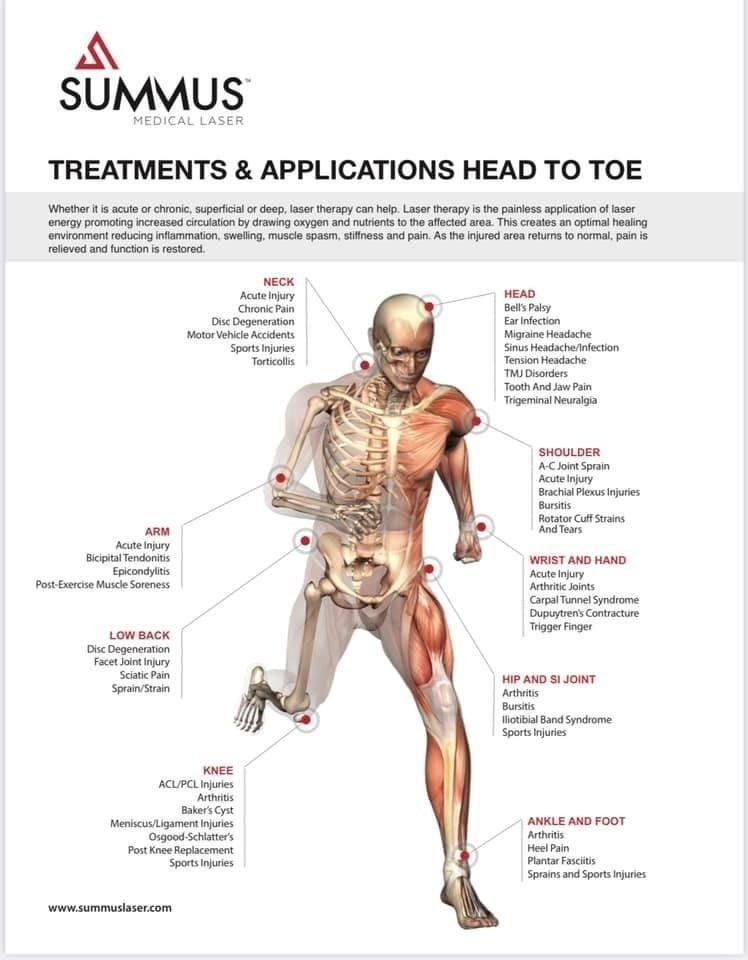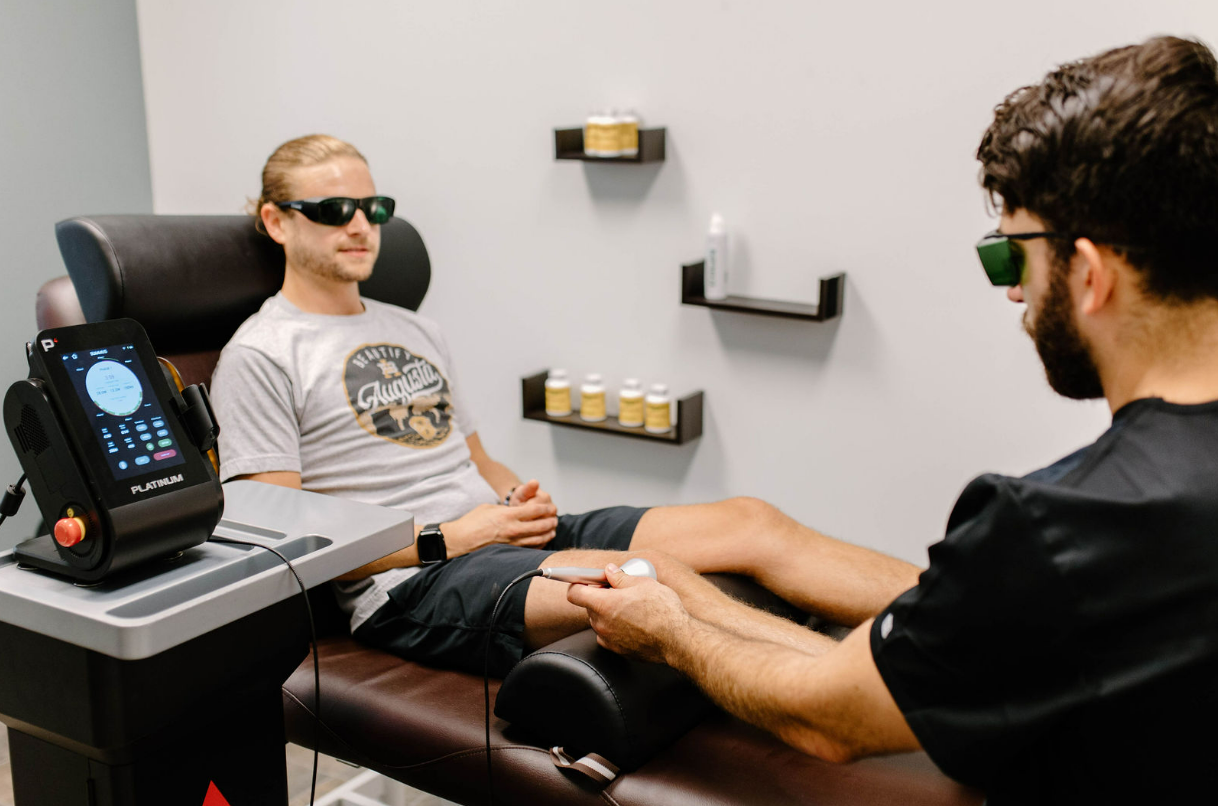Class IV Laser Therapy
Evans, GA 30809
If you are looking for chiropractic services that accelerate tissue regeneration, look no further than Evans Sport & Spine Chiropractic Center in Evans, Georgia! We are always looking for ways to improve the care that we provide to our patients by utilizing the most modern technological tools like Class IV Laser Therapy. We provide laser therapy options that utilize the specific placement of light waves to problem areas in order to improve circulation and promote healing that reduces pain, swelling, and inflammation in problem areas such as your neck, back, or joints.
Our laser therapy treatments are safe for patients of all ages and are cleared by the FDA. Whether our patient is a child looking to relieve an athletic injury, an adult suffering from knee pain, or a senior citizen wanting relief from their hip pain, our chiropractic professionals can help provide relief from various issues.
We Treat:
Sciatica
Headaches
Migraines
Post-Surgery Recovery
Range Of Motion Problems
Whiplash
Loss Of Flexibility
Carpal Tunnel
Plantar Fasciitis
Strains And Sprains
Knee Pain
Sinus Problems
Auto Injuries
Work-Related Injuries
and more
Laser History and Science
Compared to ordinary light, laser light eaves are synchronized. The peaks and troughs of the waves match up in a phenomenon called coherence. Laser light can be collimated with a lens, as demonstrated by a laser pointer, whereas ordinary light spreads out in all directions.
Finally, laser light is monochromatic - it is of one wavelength or color (+/- a few nanometer due to diode production). It is this characteristic that is responsible for a laser's specificity and selective effect on tissue.
All lasers work in a similar manner. The following is a very simplified explanation. A medium of some sort is composed of atoms capable of reaching a metastable or "excited" state. This medium is charged by an external energy source that pumps the atoms to reach their excited state. When the atoms fall back to their stable state, they give off energy in the form of a photon of light. These photons are contained within a resonating chamber with mirrors on either end.
As the number of atoms in the excited stage increases, the chance of the photons emitted spontaneously hitting another atom in the excited stage to "stimulate" release of a similar photon increases dramatically. The resonating chamber amplifies this stimulation exponentially until laser light is produced. This light is then directed externally and guided to the target tissue.
Of course, this all take place virtually instantaneously. The chemical medium will dictate the wavelength of light that is produced, and the wavelength will dictate to what function this laser is best suited.
Laser light in the red and near-infrared spectrum has biostimulatory properties, meaning that is can reduce inflammation, provide analgesia, and most importantly, enhance repair/remodeling/regeneration of tissue. Wavelength between 600nm and 100nm are used in laser therapy. The shorter red wavelength are absorbed more superficially and therefore do not have the ability to penetrate as readily as the longer near-infrared wavelength. Wavelengths in the visible red range (650nm) are highly absorbed by melanin and other superficial receptors. These can enhance wound healing. They may also stimulate trigger points, acupuncture points, and/or cause release of secondary messengers that may improve other deep-seated conditions.
Absorption spectra data shows that the wavelengths near 980nm have moderate increased absorption by water. With the higher-powered lasers this can create some thermal gradients and increase circulation in these areas. It is also near the peak of the oxygenated hemoglobin dissociation curve. However, the 915nm wavelength is even closer tot he peak of the hemoglobin dissociation curve. Recent studies have indicated that this wavelength creates as much as a 30-50% increase in molecular oxygen (O2) release to the tissue over the 980nm wavelengths.
The most important discovery was related to wavelengths nearer the 810nm range (750-830nm). These are at the peak of absorption for the cytochrome-c oxidase enzyme. This is the rate-limiting step in the conversion of O2 to adenosine triphosphate (ATP) within the electron transport cycle. These wavelengths will accelerate the production of ATP with the mitochondria.
We have emphasized the importance of wavelength for the proper clinical applications. Power is the second most important parameter that will dictate laser therapy effectiveness. A higher-powered laser shines brighter light at the surface, so that the more light can get to deeper tissues. Power is also the rate of energy delivery, so a higher-powered therapy laser can deliver a therapeutic dosage of light to a larger area (and this, tissue volume) in the patient. Stimulating the primary effect of laser therapy, the absorption of light to biostimulate damaged tissues in a large volume, explains the superior clinical outcomes of Class IV laser therapy.
Dosage is the amount of energy applied per unit area, and is measured in joules per squared centimeter. J/cm2. To. Calculate the dosage, simply divide the total amount amount of energy delivered by the actual area treated with the therapy laser. For example, 500 joules delivered over 200 CM2 gives a dosage of 2.5 J/cm2.
- Dosage is the amount of energy applied per unit of area, and is measured in joules per square cent
You could use a ruler to measure the treatment area on the patient. However, a quick estimator is to use the palm of your hand. Take a ruler and measure your palm in centimeters, it is about 10cm x 10cm, or 100cm2. (unless you have very large or small hands!) To estimate the treatment area on your patient, count the number of "palms" to be treated, and multiply by 100 to get cm2.
There is a certain dosage that is needed to elicit a clinical response in the target tissue. Laser therapy penetration and dosage is an important concept which many tests fail to address when discussing treatment parameter. The scatter and absorption coefficients and the optics of the target tissue will determine the rate of decay of the incident beam. The success you will have with any therapeutic laser is a result of the wavelength of light and the power which it can deliver. The only statement that can be made with certainty is: "if you do not deliver adequate dosage, there will be little to no effect from laser therapy".
A particularly important concept to remember is that you cannot completely make up for a lack of power with time. (For example, you cannot turn on a single light bulb and bulb wait awhile for the room to get brighter!) Due to the nature of light and the constant scatter and absorption, you must have at least a minimum threshold of power to deliver the proper dosage depending on the size and depth of the condition being targeted. That' why it is so important to have a Class IV therapy laser!

The power density is a measure of the concentration of the laser light. It is calculated by dividing the output power by the spot size area and is expressed in watts per square centimeter, W/cm2. The spot size can be changed on the zoom handpiece. For most of your pain management and injury treatments you will have the zoom open to the widest setting. This will deliver the proper power density for the body part protocol selected.
Pulsing in laser therapy refers to the number of times per second the laser light flashes ON and OFF. The pulse rate of the Horizon laser varies from 1 to 20,000 times per second, or Hertz (Hz). Continuous wave and pulse from 2-50Hz seem to be better for pain modulation while frequencies around 5000Hz address inflammation, and higher pulse rates at 10,000Hz seem to address infections. This is not "settles science" but is more based on empirical observations as stated in Tuner and Hode's "Laser Therapy Handbook".
Different tissue types also seem to respond more efficiently to differing pulse rates. It may not be as simple as the rate but even the amount of time the laser is on vs. off could affect tissue response in a more positive manner. These are still being studied but current literature consistently shows that adding 3 pulse frequencies to your treatment protocols produces better results overall than just continuous wave (CW) delivery. Adjustable power and pulsing frequencies give you the versatility to treat a wider range of clinical conditions both superficial (dermatologic) and deep (musculoskeletal/neurologic); acute and chronic, and mild and severe.
Intense superpulse (ISP) is another laser delivery mode which aids in penetration and mitigating thermal and absorption effects of pigmented tissue. It is the laser's average power not "peak" power that determines dose delivery and therefore clinical effectiveness. The Horizon laser is operating at a 60% duty cycle in the ISP mode.
In ISP mode a therapeutic dosage can be delivered to deeper targets while minimizing superficial heating. As an example, you could run 12 watts CW on your arm, and compare that with ISP mode at 12 watts average - the ISP mode will feel slightly "cooler" due to the thermal relaxation time between pulses.
Schedule Your Laser Treatment Today
Don't suffer from pain in your neck, back, or joints for longer than you have to. Our chiropractic professionals can provide you with quality laser therapy services that can help relieve your pain and help you on the path to recovery. Call us today at 706-305-9046 to schedule your laser therapy appointment.


